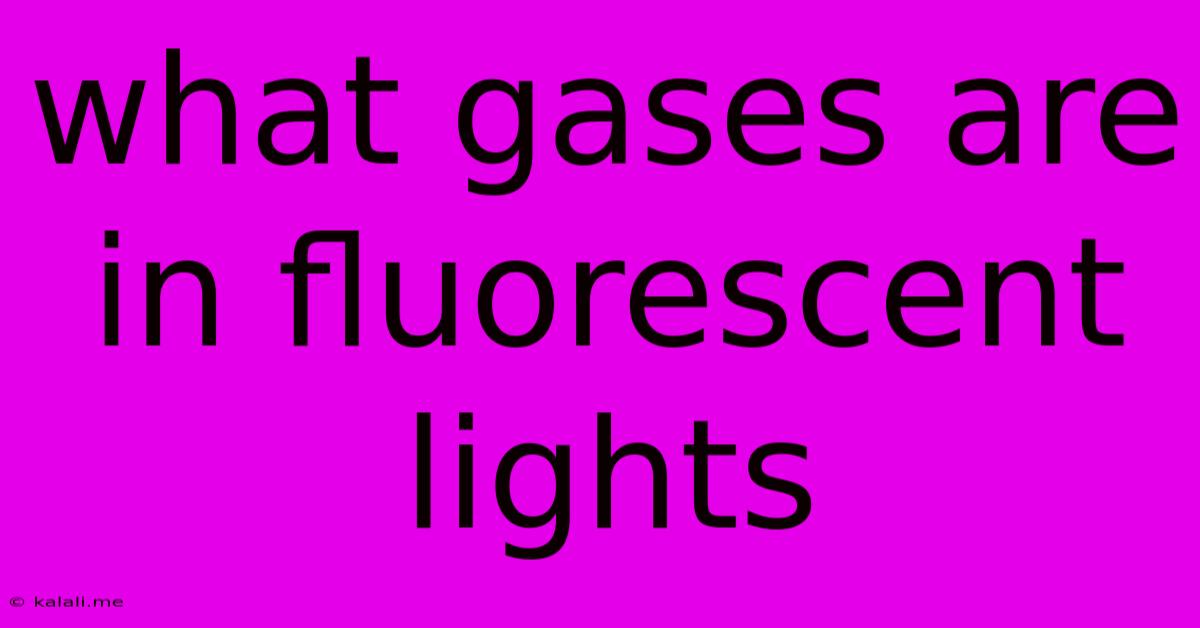What Gases Are In Fluorescent Lights
Kalali
Jun 15, 2025 · 3 min read

Table of Contents
What Gases Are in Fluorescent Lights? A Deep Dive into the Science Behind the Glow
Fluorescent lights, a common fixture in homes and offices for decades, produce light through a fascinating process involving specific gases. Understanding the composition of these gases is key to appreciating how these energy-efficient lights work and their environmental impact. This article explores the gases used in fluorescent lighting, their properties, and the ongoing evolution of this technology.
The Primary Gas: Mercury Vapor
The core component of a fluorescent light's gas mixture is mercury vapor. This is not pure mercury, but rather mercury in its gaseous state. While mercury itself is a toxic heavy metal, the amount contained within a fluorescent tube is relatively small and sealed within the glass. However, proper disposal is crucial due to environmental concerns. The mercury vapor plays a vital role in the light production process, acting as the source of ultraviolet (UV) radiation.
The Inert Gas: Argon (and sometimes Krypton or Neon)
To facilitate the ionization process and improve the efficiency of the discharge, mercury vapor isn't used alone. It's mixed with an inert gas, most commonly argon. Argon's inert nature prevents it from reacting with the mercury or the other components within the tube. This creates a stable environment for the electrical discharge. In some specialized fluorescent tubes, other inert gases like krypton or neon might be used instead of or in addition to argon, subtly influencing the light's color temperature and efficiency.
The Role of Phosphor Coating
It's crucial to understand that the mercury vapor itself doesn't produce the visible light we see. The mercury vapor emits primarily ultraviolet (UV) light. The inside of the fluorescent tube is coated with a layer of phosphor, a material that absorbs the UV radiation and converts it into visible light. Different phosphor types can create various color temperatures, from the cool white of many office lights to warmer, more yellowish hues. The phosphor coating is what determines the final color output of the fluorescent light.
Beyond the Basics: Variations and Improvements
Fluorescent light technology is constantly evolving. While the basic principle remains the same – using mercury vapor and an inert gas to produce UV radiation which is then converted to visible light via a phosphor coating – improvements focus on:
- Increased Efficiency: Research continually aims to optimize the gas mixture and phosphor coating to improve energy efficiency and reduce mercury content.
- Improved Color Rendering: Advances in phosphor technology allow for better color rendering, meaning colors appear more accurately under fluorescent lighting.
- Reduced Environmental Impact: Efforts are focused on creating more sustainable and eco-friendly fluorescent lights, including reducing mercury content and improving recycling processes.
Safety Considerations:
While the amount of mercury in a typical fluorescent tube is relatively small, it's essential to handle broken tubes with care. Mercury vapor is toxic, and inhalation should be avoided. Always follow proper disposal procedures when discarding fluorescent lights.
In summary, fluorescent lights utilize a combination of mercury vapor and an inert gas, typically argon, to produce ultraviolet radiation. This UV radiation is then transformed into visible light through a phosphor coating on the inner surface of the tube. Understanding this gas composition and the related technology allows us to appreciate the workings and ongoing improvements in these widely used lighting solutions.
Latest Posts
Latest Posts
-
Which Of These Is Not Normally Found In Urine
Jun 15, 2025
-
The Panama Canal Connects Which Two Oceans
Jun 15, 2025
-
What Is The Lcm Of 2 3 6
Jun 15, 2025
-
Change The Following Sentences As Directed In The Bracket
Jun 15, 2025
-
Which 2 Countries Share The Longest Border
Jun 15, 2025
Related Post
Thank you for visiting our website which covers about What Gases Are In Fluorescent Lights . We hope the information provided has been useful to you. Feel free to contact us if you have any questions or need further assistance. See you next time and don't miss to bookmark.